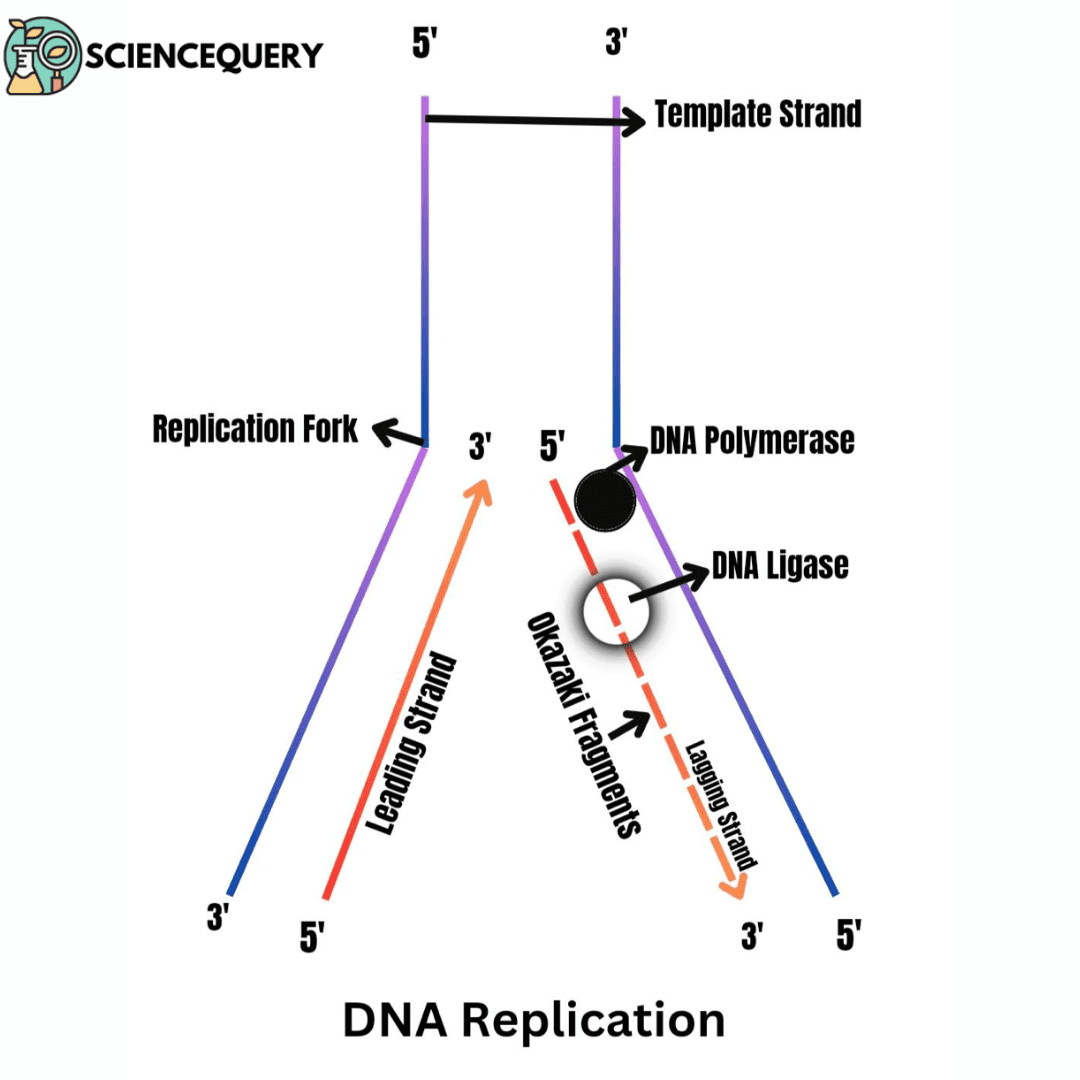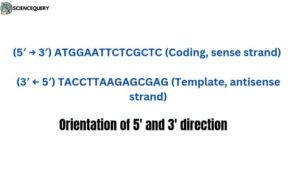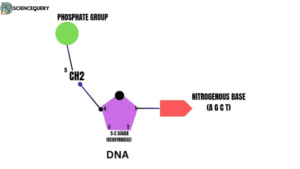
Introduction
DNA is the fundamental building block of an organism’s genetic information. It consists of two long strands made up of four different nucleotide bases (adenine, cytosine, guanine, and thymine). These strands form a double helix shape and are joined together by hydrogen bonds. The phosphate groups are responsible for holding together two strands of complementary deoxyribonucleotides, forming the “backbone” of a DNA double helix.
The template strand in DNA serves as a template for transcription. It contains genetic information necessary to produce proteins and other molecules, and it is complementary to the coding strand.
The coding strand in DNA contains the genetic information necessary for protein synthesis.
Structure Of DNA
Nucleotides are joined together by phosphodiester linkage between 5’ and 3’ carbon atoms of pentose sugar. The chains of nucleic acid are written in left-right order fashion.
- Edwin Chargaff reported that the net amount of adenine was equal to thymine (A=T)
- It means that the total number of purines is equal to the total number of pyrimidines (A+G = T+C)
- AT/CG ratio = 1.52 and 0.93 in E.coli.
- The diameter of a double helical structure of DNA is 2nm.
- The total distance covered in 10 base pairs or 1 complete turn is 3.4nm.
Definition of template and coding strands
- The two strands of the DNA molecule are separated from each other, thus exposing the nitrogenous bases.
- One strand is actively used as a template strand in the transcription process. This strand is known as the sense strand or template strand.
- Transcription is the synthesis of a single-stranded RNA directly by the DNA using one of its strands as the template. In this process, the genetic information present in DNA is transferred to the RNA molecule.
- The complementary DNA strand that is not used is known as the antisense or coding strand.
Functions
The RNA molecule transcribed is a direct complementary copy of the nitrogenous bases in the template or antisense strand. It is identical to the non-template strand of the DNA except for the thymine-uracil combination.
RNA transcribed will be an exact copy of the coding strand and complementary to the template strand.
Orientation and 5’ and 3’ direction
DNA is a two-stranded molecule. Each strand is a polynucleotide composed of Adenosine, Thymidine, Cytidine, and Guanosine. Each strand has polarity such that the 5′-hydroxyl group of the first nucleotide begins the strand and the 3’-hydroxyl group of the final nucleotide ends the strand.
Significance
The two strands of DNA run antiparallel to each other such that one strand is 5’— 3’ while the other runs 3’— 5’. This is the reason DNA has been referred to as the ‘double helical structure’.

Base pairing and complementarity
Base pairing rule
The two strands of helical are anti-parallel.
Between A and T, there are 2 hydrogen bonds (A=T) and in between C & G, there are 3 hydrogen bonds. The C & G base pairing contains three double bonds and thus more stability than the A=T.
Concept of complementarity
DNA complementarity is the method where two strands of DNA bind together due to their complementary base sequences. It is based on the fact that each strand contains four different types of bases: Adenine (A), thymine (T), guanine (G), and cytosine (C).
Replication process
DNA strands are replicated to create two identical copies. This process involves the pairing of complementary nucleotides, or bases, on opposite strands of DNA.
Role of enzymes in replication
Transcription process related to template and coding strand- Transcription is the process by which DNA is read by RNA polymerase II and an RNA strand is built based on its sequence.
The following enzymes are used in the replication process of DNA.
- This enzyme is responsible for synthesizing new strands of DNA from existing ones by substitution of nucleotides to them.
- Primase – They are responsible for creating short RNA primers that act as starting points for the synthesis of new strands of DNA.
- Helicase – This enzyme unwinds and separates the ds-DNA so that they can be replicated separately. It thus allows both strands to be copied during the replication process.
- Topoisomerases – They help in relieving tension caused by winding or unwinding single-stranded regions during replication.
Functional difference between template vs coding strands table form.
Template Strand |
Coding Strand |
| It is also known as the antisense strand. | It is known as the sense strand. |
| Polarity is from 3’– 5’ | Polarity is from 5’– 3’ |
| It functions as a template for the transcription process and codes for RNA. | During transcription, it does not code for RNA. |
Q&A
1. What is the difference between the template and coding strand of DNA?
The difference between the template and coding strand of DNA is that the template strand contains information for protein synthesis. The coding strand does not. The template strands contain codons that code for amino acids during transcription, while the coding strands do not contain any codons.
2. Why is the coding strand not transcribed?
The coding strand of DNA is not transcribed because it contains the instructions for making proteins, and these instructions are already present in the mRNA molecule.
3. What is the difference between a template and a complementary strand?
The difference between a template and a complementary strand is that the template strand provides the sequence of nucleotides for replication, while the complementary strand is created during DNA replication.
Summary
- If we compare between template vs coding strand then we can say that the template strand in DNA serves as a base for transcription. The coding strand in DNA contains the genetic information necessary for protein synthesis.
- DNA is the fundamental building block of an organism’s genetic information.
- It consists of two long strands made up of four different nucleotide bases (adenine, cytosine, guanine, and thymine).
- These strands form a double helix shape and are joined together by hydrogen bonds.
- The phosphate groups are responsible for holding together two strands of complementary deoxyribonucleotides, forming the “backbone” of a DNA double helix.
- The difference between the template and coding strand of DNA is that the template strand contains information for protein synthesis. The coding strand does not.
- The template strands contain codons that code for amino acids during transcription, while the coding strands do not contain any codons.
References
- https://www.nature.com/articles/nmeth.2206
- https://www.medixbiochemica.com/media/medix/amfile/attach/_8701_Isotherm3G_DNA_Polymerase_manual_v1.pdf
- https://www.sciencedirect.com/science/article/pii/S0005272898001613
- https://link.springer.com/chapter/10.1007/0-306-47606-1_14
- https://febs.onlinelibrary.wiley.com/doi/abs/10.1111/febs.13307
- https://www.cabdirect.org/cabdirect/abstract/19901615648
- https://www.jstor.org/stable/24996643
Written By: Sushmita Mukhopadhyay

